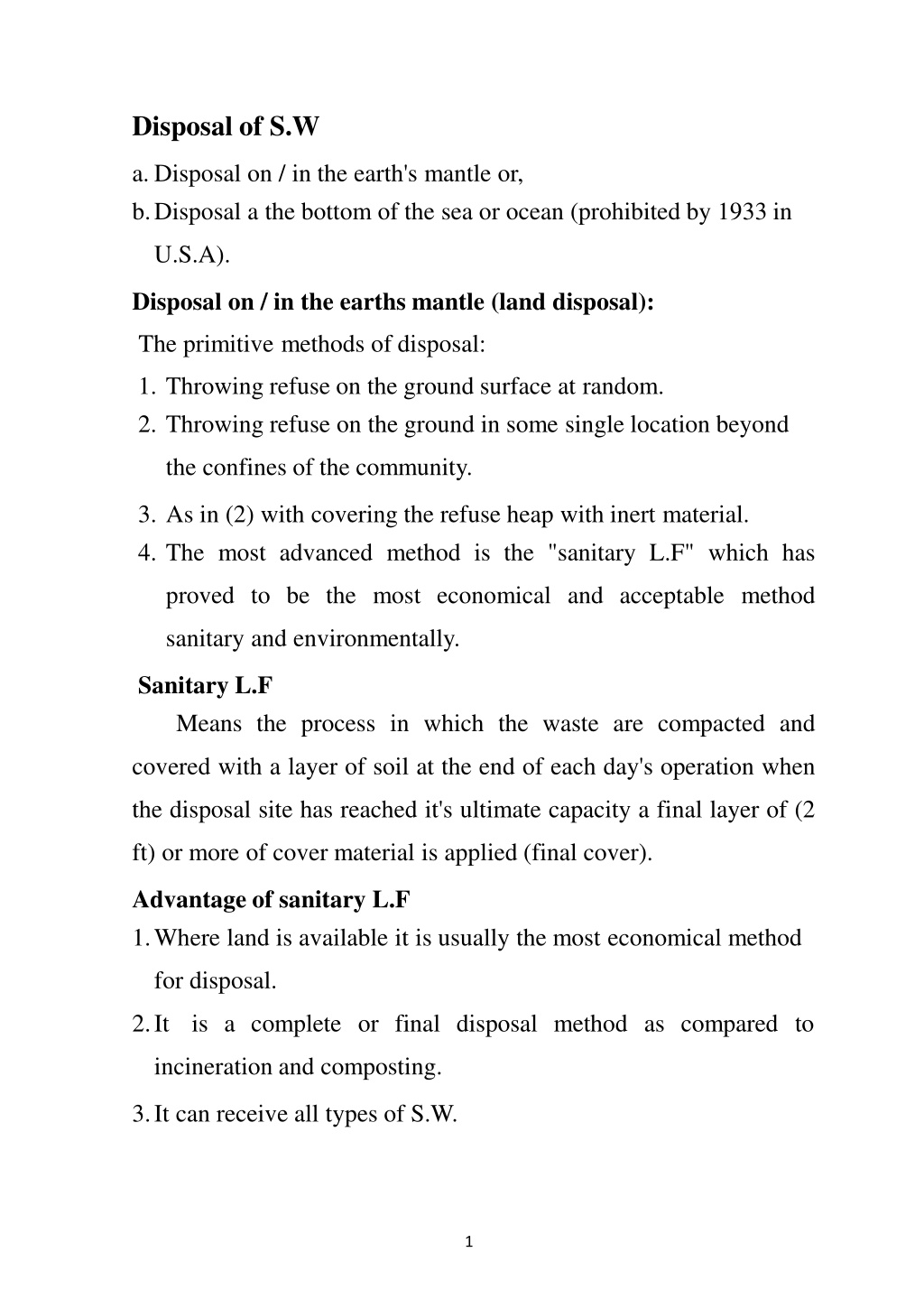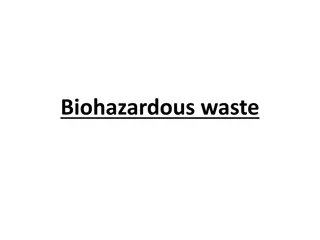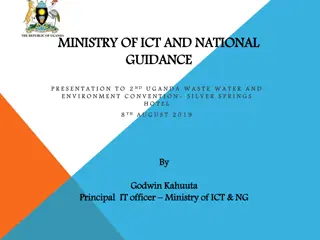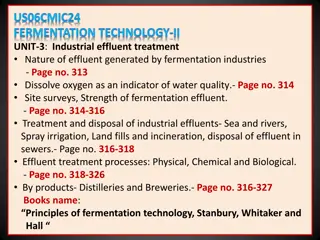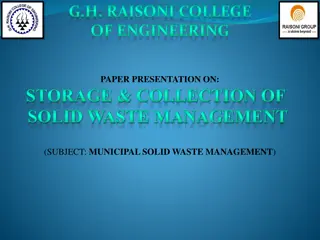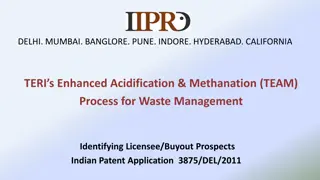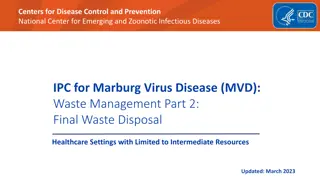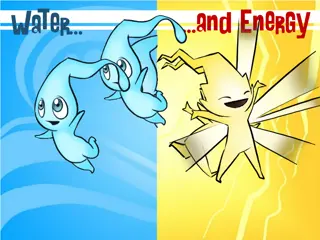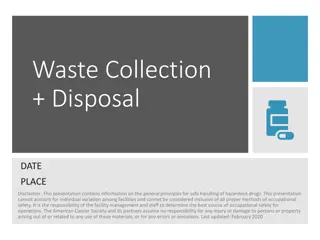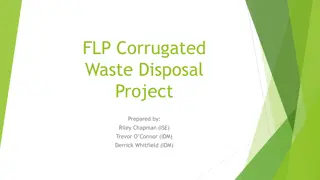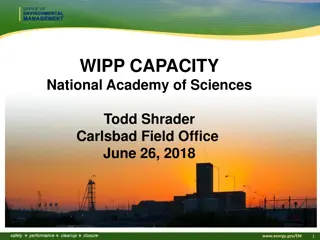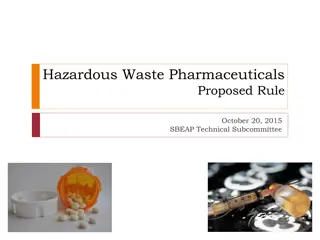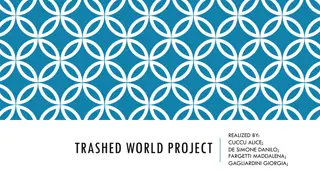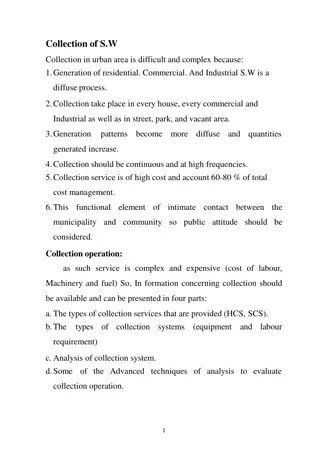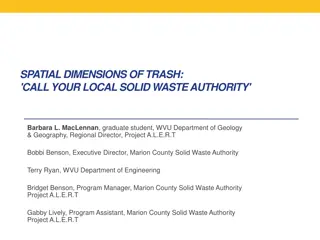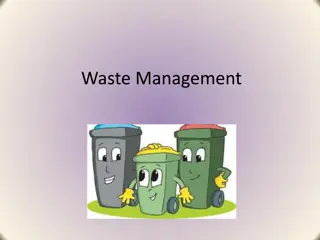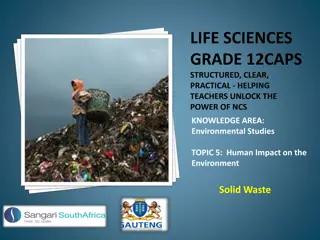Efficient Methods and Considerations for Solid Waste Disposal
Efficient methods for solid waste disposal include sanitary landfilling, which involves compacting waste and covering it with soil daily. Advantages of this method include economic viability and flexibility in waste disposal. However, challenges such as limited suitable land availability and potential hazards like methane generation need to be addressed. Factors to consider in landfill site selection include land area, public opposition, climatic conditions, and potential uses for the site. Operational methods like area and trench methods are used based on the terrain, with specific techniques for waste compaction and covering.
- Waste disposal
- Sanitary landfill
- Landfill site selection
- Environmental considerations
- Waste management
Download Presentation

Please find below an Image/Link to download the presentation.
The content on the website is provided AS IS for your information and personal use only. It may not be sold, licensed, or shared on other websites without obtaining consent from the author. Download presentation by click this link. If you encounter any issues during the download, it is possible that the publisher has removed the file from their server.
E N D
Presentation Transcript
Disposal of S.W a. Disposal on / in the earth's mantle or, b.Disposal a the bottom of the sea or ocean (prohibited by 1933 in U.S.A). Disposal on / in the earths mantle (land disposal): The primitive methods of disposal: 1. Throwing refuse on the ground surface at random. 2. Throwing refuse on the ground in some single location beyond the confines of the community. 3. As in (2) with covering the refuse heap with inert material. 4. The most advanced method is the "sanitary L.F" which has proved to be the most economical and acceptable method sanitary and environmentally. Sanitary L.F Means the process in which the waste are compacted and covered with a layer of soil at the end of each day's operation when the disposal site has reached it's ultimate capacity a final layer of (2 ft) or more of cover material is applied (final cover). Advantage of sanitary L.F 1.Where land is available it is usually the most economical method for disposal. 2.It is a complete or final disposal method as compared to incineration and composting. 3.It can receive all types of S.W. 1
4.It is flexible process, as increased quantity of S.W can be disposed of with little additional personal or equipment. 5.Sub marginal land may be reclaimed for various uses (parking lots, play group). Disadvantage. 1.Suitable land many not be available. 2. Methane and other gar generated many be hazards. Aspects of the design and operation of sanitary L.F. 1.Factors in land fill site selection. 2.Land filling methods. 3. Gas and leachate movement and control. Site Selection In site selection, consideration should be given to the following variables: 1. Available land Area. 2. Public opposition. 3. Proximity of major road ways. 4. Haul distance, speed time, load limits. 5. Traffic patterns and congestion. 6. Soil condition and topography (availability of cover Material ) 7. Climatological conditions. 8. Surface water hydrology. 9. Local environmental conditions. 10. Potential ultimate uses for of the complete site . 11. Buffer area around the site. 2
Land area requirement: In selection of potential land site, it is important to assure that sufficient land (volume) area is available to operate for at least one year at a given sits. It is common to find disposal sufficient for (5- 10) years operations. Landfilling methods and operations. Operational methods based on situation of the available land as: 1. Fill of dray area. 2. Fill of wet area (where the area contain water). Conventional methods used for filling (dry areas) include the following: 1.Area methods. 2.Trench methods. 1. Areamethods: Usually used when terrain is unsuitable for the excavated of trenches to place the wastes, the operation as follows: The waste are unloaded and spread in long, narrow strips, on the surface of the land in a series of layer that vary in depth from 16-30 inches. Each layer is compacted as the filling progresses during the course of the day until the total depth (thickness) of the compacted wastes reach a height (6-10) ft. At that time and the end of the day (operational) a (6-12) inches layer of cover material (daily cover) which is usually hauled in by truck from adjacent land. 3
The width over which wastes are compacted varies from 8-20 ft. A completed lift over which the waste are completed and then covered with earth during one day is called (cell). 2. Trenchmethods: It is ideally suitable to area where an adequate depth of cover material is available at the site Trench of length (100-400) ft, (3-6) depth and (15-25)ft width are excavated into which S.W are placed spread into layers (18- 24)inches thick compacted it. - The operation is continued until the desired height is reached. - Caver material is to brained by excavating on adjacent trench or containing the trench that is being filled. 4
Conventional Methods for wet areas - Swamps, Marshes, tidal area and ponds are typical wet areas. - Special treatment is required to control the contamination of ground water. - In the past, the usual practice was to divide the area into cells, so that one cell is filled each year. - To withstand the mud moves and to increase structural stability dikes are used to divide the cell or lagoons. - More recently because of concern of the possibility of ground and surface water contamination by both leachate and gases from L.F the direct filling is not acceptable. - Special provision must be used to contain or eliminate the movement of leachate and gases from completed L.F as follows: 1.Draining the site before using it for L.F. 2.Lining the bottom with clay liner. 5
Leachate in L.F Leachate can be defined as liquid that has percolated through S.W and has extracted dissolved or suspended material from it (S.W) It composed of: 1.Liquid that has entered the left from external source (surface drainage, rainfall, G.W). 2.Liquid produced from the decomposition of the wastes. In its movement through S.W, both chemical and biological constituents are picked up and the pollutant contents in atypical leachate as shown in table. Constituent BOD(mg/l) TOC COD TSS PH value Alkalinity Org (N) (mg/l) rage typical 10000 6000 18000 500 6 3000 200 2000-30000 15000-20000 3000-45000 200-1000 5.2-8.5 1000-10000 10-600 The quantity of leachate formed in a L.F is a function of the amount of external water entering the L.F. Leachate quantity depends on the following factors: 1.Final cover material (carefully graded) and permit runoff without causing erosion. 2.Surface slope to provide and accelerate runoff (2-4%). 3. Type of vegetation cover and amount. 4.Permeability of cover material. 6
5.Settlement of cover material. 6.Surface drainage around fill area. Gas and leachate at Movement and Control: The gas generated in L.F Should be either 1.Vented to the atmosphere or. 2.Collected for the production of energy ( in large L.F sites). The leachate should be either: 3.Contained within the L.F. 4.Removal for treatment. Control of leachate movement As leached percolate through the under laying strata, many of chemical and biological consistent in leachate will be removed by filtering and adsorption action depending on the characteristics of the soil forming risks to contamination of G.W. the practice used to eliminate or contain the leachate is by the use suitable sealant material. it may advantageous to circulate (recycle) leachate through L.F. Ultimately it may be necessary to collect and treat the leachate. clay layer or membrane liners can be used to prevent or reduce the leachate percolation. Elimination of surface water infiltration (using impermeable clay final cover. Appropriate surface slope for the finished top cover and adequate drainage, surface infiltration can be controlled effectively. 7
Surface drainage to deliver runoff faraway and good vegetation are effective means. Gas Movement: Over 90% of the gas volume produced from a L.F site consists of and When gas present in the air concentration between 5-15% it become explosive (due to present of ) However there is no in a L.F when concentration reached this critical level and so no danger of L.F will explode. -Most of the methane gas escape to the atmosphere sine its density is lower than that of the air (density of CH4= 0.717 g/l, and that of CO2= 1.42 g/l, CO density= 1.25 g/l, and of N2=1.54 g/l. - But lateral movement of was observed at 400 ft from the edge of the fill area. - For unvented L.F the extent of lateral movement depend on the characteristics of the cover material and surrounding Soil. - This may lead to accumulation of the gas below building and close to sanitary L.F. gas is denser than air (1.5 times and 2.5 times as dense as CH4 So it tend to move to bottom of L.F and even to the under laying formation unit it reach the under ground water. Control of gas movement by permeable method The following methods can be used to control gas movement: 8
1. Cell methods: gas vents made of gravel during filling operation, spacing of cell vents depends on width of cell and varies from 60- 200 ft. usually made of thickness of 12-18 inch of gravel layer. 2. Well vents: where use perforated pipes surrounded with gravel packed to vent gas to the atmosphere . 3. Barrier vents: where a packed gravel trench is formed vertically outside the L.F area to stop any lateral movement of gas and facilitate to be vented through upward. 9
Control of gas movement by impermeable methods To prevent L.F gases through adjacent formation by constructing barrier of material that are more impermeable than the soil by using some type of sealants such as compacted soil, clay or bentonite, synthetics chemicals (polymers, rubber, latex), synthetics membrane (butyl rubber, PVC, polyethylene, nylon, reinforced liners),asphalt, soil cement, plastic soil cement). Clay liner thickness depend on type and clay thickens from (6- 48) inches. The clay linear should be constructed as the filling progresses to avoid air drying (shrinkage or crack in clay). The installation of impermeable barrier is of special importance where L.F gas is to recovered . 10
